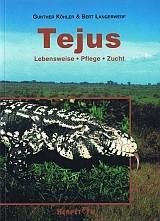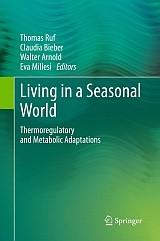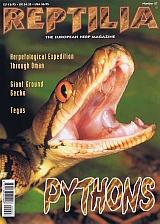




Related bibliographies:
Reptiles
 Lizards Lizards
 Teiidae Teiidae
South America






































































































































































































































































































































| |

Bibliography of the genus
Salvator (Southern Tejus)

(Reptilia: Sauria: Teiidae)
Note:
In order to limit redundancy, relevant literature indexed in the related bibliographies in the left column may not have been included in this page. For a comprehensive search of literature, these bibliographies should therefore also be consulted.
Salvator in general
 |
Abe, A.S.; Pesantes, O.S.; Manzani, P.R. 1992. Consideracões sobre a gênero Tupinambis (Lacertilia, Teiidae). - Resumos XII Congresso Latinoamerican de Zoologia, XIX Congresso Brasileira de Zoologia. Belem, Para. 128 pp.
Harvey, M.B.; Ugueto, G.N.; Gutberlet, R.L. 2012. Review of teiid morphology with a revised taxonomy and phylogeny of the Teiidae (Lepidosauria: Squamata). Zootaxa 3459: 1-156.
|
Salvator duseni
 |
Campos, V.A.; Oda, F.H.; Custodio, R.J.; Felismino, M.F. 2011. Natural history notes: Eunectes murinus (Green Anaconda). Diet. Herpetological Review 42(1): 99.
Campos, V.A.; Oda, F.H.; Custodio, R.J.; Koppe, V.C.; Dartora, A. 2011. First state record and distribution extension of Tupinambis duseni Lonnberg, 1910 (Squamata: Sauria: Teiidae) from Mato Grosso state, central Brazil. Herpetology Notes 4: 1-3.
Oliveira Drummond, L. de; Rosário-Cruz, A.J. do; Caldeira Costa, H.; Carvalho Braga, C.A. de 2014. New records of the teiid lizards Kentropyx paulensis (Boettger, 1893) and Tupinambis duseni Lönnberg, 1910 (Squamata: Teiidae) from the state of Minas Gerais, southeastern Brazil. Check List 10(6): 1549-1554.
Peres, A.K.; Colli, G.R. 2004. The taxonomic status of Tupinambis rufescens and T. duseni (Squamata: Teiidae), with a redescription of the two species. Occasional Papers Sam Noble Oklahoma Museum of Natural History 15: 1-12.
|
Salvator merianae
 |
Achaval, F.; Langguth, A. 1972. Nota sobre habitos anfibios de Tupinambis teguixin teguixin (L.) (Teiidae, Sauria). Boletin Soc, Zool. Uruguay 2: 107.
Agudo-Padron, A.I.; Lenhard, P. 2013. First record of predation on freshwater snails Pomacea canaliculata (Lamarck, 1819) by the terrestrial lizards Tupinambis (= Salvator) merianae Linnaeus, 1758 in the southernmost Brazil region. Ellipsaria 15(3): 24-25.
Andrade, D.V.; Sanders, C.; Milsom, W.K.; Abe, A.S. 2004. Overwintering in Tegu Lizards. Biological Papers of the University of Alaska 27: 339-348.
Assencio Machado, R. 2007. Natural history notes: Tupinambis merianae (Tiu, Teiu, Tegu, or Teju). Diet. Herpetological Review 38(1): 84.
Barreto-Lima, A.F.; Camilotti, V.L. 2009. Tupinambis merianae: ophiophagy. Herpetological Bulletin 109: 36-38.
Barros, F.C. de; Carvalho, J.E. de; Abe, A.S.; Kohlsdorf, T. 2010. Fight versus flight: the interaction of temperature and body size determines antipredator behaviour in tegu lizards. Animal Behaviour 79(1): 83-88.
Barros, F.C. de; Carvalho, J.E. de; Abe, A.S.; Kohlsdorf, T. 2016. Beyond body size: muscle biochemistry and body shape explain ontogenetic variation of anti-predatory behaviour in the lizard Salvator merianae. Journal of Experimental Biology 219(11): 1649-1658.
Bovendorp, R.S.; Alvarez, A.D.; Gialetti, M. 2008. Density of the Tegu Lizard (Tupinambis merianae) and its role as nest predator at Anchieta Island, Brazil. Neotropical Biology and Conservation 3(1): 9-12.
Brito, S.P.; Abe, A.S.; Andrade, D.V. 2001. Natural history notes: Tupinambis merianae (Tegu Lizard). Longevity. Herpetological Review 32(4): 260-261.
Brizuela, S.; Albino, A.M. 2010. Variaciones dentarias en Tupinambis merianae (Squamata: Teiidae). Cuadernos de Herpetologia 24(1): 5-16.
Bueno Gavira, R.S. 2018. Another case of Rhinella schneideri (Werner, 1894), devoured by Salvator merianae Dumeril & Bibron, 1839. Herpetozoa 31(1-2): 99-100.
Cabana, I.; Gardenal, C.N.; Chiaraviglio, M.; Rivera, P.C. 2014. Natural hybridization in lizards of the genus Tupinambis (Teiidae) in the southernmost contact zone of their distribution range. Annales Zoologici Fennici 51(3): 340-348.
Canepuccia, A.D. 2000. Tupinambis merianae, the black Tegu. Reptilia (GB) 10: 48-55.
Cardozo, G.; Naretto, S.; Blengini, C.S.; Chiaraviglio, M. 2015. Phenotypic diversity in female body shape is related to reproductive potential in Tupinambis merianae lizards. Annales Zoologici Fennici 52(3): 129-144.
Castro, E.R. de; Galetti, M. 2004. Frugivoria e dispersao de sementes pelo lagarto Teiu Tupinambis merianae (Reptilia: Teiidae). Papeis Avulsos de Zoologia (São Paulo) 44(6): 91-97.
Chamut, S.; Jahn, G.A.; Arce, O.E.A.; Manes, M.E. 2012. Testosterone and reproductive activity in the male Tegu lizard, Tupinambis merianae. Herpetological Conservation and Biology 7(3): 299-305.
Chiarello, A.G.; Srbek-Araujo, A.C.; Del-Duque, H.J.; Coelho, E. de R.; Rocha, C.F.D. 2010. Abundance of tegu lizards (Tupinambis merianae) in a remnant of the Brazilian Atlantic forest. Amphibia-Reptilia 31(4): 563-570.
Duarte Varela, C.F.; Cabrera, M.R. 2000. Testing skeletochronology in black Tegu Lizards (Tupinambis merianae) of known ages. Herpetological Review 31(4): 224-226.
Duarte, M.R. 2016. Natural history notes: Philodryas patagoniensis (Patagonian Racer). Diet. Herpetological Review 47(3): 481.
Fabre, A.C.; Andrade, D.V.; Huyghe, K.; Cornette, R.; Herrel, A. 2014. Interrelationships between bones, muscles, and performance: biting in the lizard Tupinambis merianae. Evolutionary Biology (New York) 41(4): 518-527.
Fabre, A.C.; Cornette, R.; Huyghe, K.; Andrade, D.V.; Herrel, A. 2014. Linear versus geometric morphometric approaches for the analysis of head shape dimorphism in lizards. Journal of Morphology 275(9): 1016-1026.
Giambelluca, L.A. 2010. [Geophagy in Tupinambis merianae (Sauria: Teiidae) during hibernation]. (In Spanish). Boletin de la Asociacion Herpetologica Espanola 21: 46-49.
Hanslowe, E.B.; Calafiore, C.V.; Sykes, K.N.; Ee, N. van; Falk, B.G.; Yackel Adams, A.A.; Reed, R.N. 2017. Natural history notes: Salvator merianae (Argentine Tegu). Attempted predation. Herpetological Review 48(3): 659-660.
Herrel, A.; Andrade, D.V.; Carvalho, J.E. de; Brito, A.; Abe, A.S.; Navas, C. 2009. Aggressive behavior and performance in the Tegu Lizard Tupinambis merianae. Physiological and Biochemical Zoology 82(6): 680-685.
Kaiser, B.W.; Osorio, K.J.; Enge, K.M.; Engeman, R.M. 2013. Natural history notes: Tupinambis merianae (Argentine Giant Tegu), Pantherophis guttatus (Red Cornsnake). Non-predatory killing. Herpetological Review 44(2): 329.
Kasperoviczus, K.N.; Krüger, A.C.; Marques, O.A.V. 2015. An elongated meal: the tegu lizard Salvator merianae eats snakes and amphisbaenians. Herpetology Notes 8: 21-23.
Kiefer, M.C.; Sazima, I. 2002. Diet of juvenile Tegu Lizard Tupinambis merianae (Teiidae) in southeastern Brazil. Amphibia-Reptilia 23(1): 105-108.
Klug, P.E.; Reed, R.N.; Mazzotti, F.J.; McEachern, M.A.; Vinci, J.J.; Craven, K.K.; Adams, A.A.Y. 2015. The influence of disturbed habitat on the spatial ecology of Argentine Black and White Tegu (Tupinambis merianae), a recent invader in the Everglades ecosystem (Florida, USA). Biological Invasions 17(6): 1785-1797.
Lana Pinto, L.C.; Rosario Cruz, A.J. do; Silverio Pires, M.R. 2015. Incorporando o conhecimento ecológico local na conservação dos lagartos da serra do Ouro Branco, Minas Gerais, Brasil. Bioscience Journal 31(2): 613-622.
Lanfri, S.; Cola, V. di; Naretto, S.; Chiaraviglio, M.; Cardozo, G. 2013. Understanding the ecological niche to elucidate spatial strategies of the southernmost Tupinambis lizards. Amphibia-Reptilia 34(4): 551-565.
Langerwerf, B. 1998. Einfluss schwankender Temperaturen auf den Schlupf bei zwei Echsenarten. Elaphe 6(3): 22-24.
Lopes Santos, D.; Vaz-Silva, W. 2012. [Tupinambis merianae (Squamata: Sauria: Teiidae): attempt at predation on Turdus leucomelas in mist nets]. (In Portuguese). Herpetologia Brasileira 1(1): 35-36.
López Juri, G.; Naretto, S.; Mateos, A.C.; Chiaraviglio, M.; Cardozo, G. 2015. Influence of life history traits on trophic niche segregation between two similar sympatric Tupinambis lizards. South American Journal of Herpetology 10(2): 132-142.
Maffei, F.; Ubaid, F.K.; Medolago, C.A.B.; Jim, J. 2009. Natural history notes: Tupinambis merianae (Common Tegu). Diet. Herpetological Review 40(4): 439.
Manes, M.E.; Noriega, T.; Campos Casal, F.; Apichela, S. 2007. Ovarian changes during the reproductive cycle of the Tupinambis merianae lizard raised in a temperate environment. Cuadernos de Herpetologia 21(1): 21-29.
Manes, M.E.; Vega Parry, H.; Manlla, A. 2007. Growth and feeding conversion responses to different protein and energy supplies in Tupinambis merianae (Squamata: Teiidae). Applied Herpetology 4(3): 279-285.
Mazzotti, F.J.; McEachern, M.A.; Rochford, M.; Reed, R.N.; Eckles, J.K.; Vinci, J.; Edwards, J.; Wasilewski, J.A. 2015. Tupinambis merianae as nest predators of crocodilians and turtles in Florida, USA. Biological Invasions 17(1): 47-50.
Milsom, W.K.; Andrade, D.V.; Brito, S.P.; Toledo, L.F.; Wang, T.; Abe, A.S. 2008. Seasonal changes in daily metabolic patterns of Tegu Lizards (Tupinambis merianae) placed in the cold (17°C) and dark. Physiological and Biochemical Zoology 81(2): 165-175.
Milsom, W.K.; Sanders, C.; Leite, C.; Abe, A.S.; Andrade, D.V.; Tattersall, G. 2012. Seasonal changes in thermoregulatory strategies of Tegu Lizards. pp. 317-324. In: Ruf, T.; Bieber, C. & Arnold, W. Living in a seasonal world. Springer, New York, Dordrecht etc. 563 pp.
Monteiro, L.R. 1999. Multivariate regression models and geometric morphometrics: the search for causal factors in the analysis of shape. Systematic Biology 48(1): 192-199.
Montuelle, S.J.; Herrel, A.; Libourel, P.A.; Daillie, S.; Bels, V.L. 2012. Prey capture in lizards: differences in jaw-neck-forelimb coordination. Biological Journal of the Linnean Society 105(3): 607-622.
Montuelle, S.J.; Herrel, A.; Schaerlaeken, V.; Metzger, K.A.; Mutuyeyezu, A.; Bels, V.L. 2009. Inertial feeding in the teiid lizard Tupinambis merianae: the effect of prey size on the movements of hyolingual apparatus and the cranio-cervical system. Journal of Experimental Biology 212(16): 2501-2510.
Mourthe, I.M.C. 2010. Natural history notes: Tupinambis merianae (Common Tegu). Feeding behavior. Herpetological Review 41(2): 232-233.
Müller, P. 1969. Über eine neue Subspezies vom Teju, Tupinambis teguixin buziosensis n. ssp. Salamandra 5: 32-35.
Muscat, E.; Olmos, F.; Rotenberg, E. 2016. Salvator merianae (Black and White Tegu) scavaging around the nests of Fregata magnificens (Frigatebird). Herpetological Bulletin 135: 36-37.
Naretto, S.; Cardozo, G.; Blengini, C.S.; Chiaraviglio, M. 2014. Sexual selection and dynamics of jaw muscle in Tupinambis lizards. Evolutionary Biology (New York) 41(2): 192-200.
Palacios, R.; Villalba, R.; Fitzgerald, L.A. 1997. Natural history notes: Tupinambis merianae (Common Tegu). Predation. Herpetological Review 28(4): 204-205.
Passos, D.C.; Fonseca, P.H.M.; Vivar, P.R.R. de; Kanayama, C.Y.; Teixeira, V.P.A.; Martinelli, A.G. 2016. Tail trifurcation in the lizard Salvator merianae (Squamata: Teiidae) investigated by computer tomography. Phyllomedusa 15(1): 79-83.
Pereira da Silva, E.A.; Santos, T.D.; Leite, G.N.; Barros Ribeiro, L. 2013. Tropidurus hispidus (Squamata: Tropiduridae) and Leptodactylus cf. fuscus (Anura: Leptodactylidae) as prey of the teiid lizards Salvator merianae and Ameiva ameiva. Herpetology Notes 6: 51-53.
Pernas, T.; Giardina, D.J.; McKinley, A.; Parns, A.; Mazzotti, F.J. 2012. First observations of nesting by the Argentine Black and White Tegu, Tupinambis merianae, in South Florida. Southeastern Naturalist 11(4): 765-770.
Pyles Cicchi, P.J.; Sena, M.A. de; Freitas, H.S. de 2006. Natural history notes: Tupinambis merianae (Tegu). Diet. Herpetological Review 37(3): 347-348.
Rêgo, B.D.P.; Kolodiuk, M.F.; Meira-Ribeiro, M.; Freire, E.M.X. 2017. Natural history notes: Salvator merianae (Argentine Black-and-White Tegu). Diet. Herpetological Review 48(3): 660.
Rossi-Santos, M.s R. 2007. Sighting of an interaction between a Neotropical otter, Lontra longicaudis and a teju lizard, Tupinambis merianae in a lagoon ecosystem of southern Brazil. IUCN Otter Specialist Group Bulletin 24: 41-46.
Santos Almeida, R.P.; Oliveira Lima, J.; Reis Dias, E.J. dos 2015. Natural history notes: Salvator merianae (Tegu). Diet. Herpetological Review 46(3): 436.
Sazima, I. 2015. Corpse bride irresistible: a dead female tegu lizard (Salvator merianae) courted by males for two days at an urban park in south-eastern Brazil. Herpetology Notes 8: 15-18.
Sazima, I.; D'Angelo, G.B. 2013. Range of animal food types recorded for the tegu lizard (Salvator merianae) at an urban park in south-eastern Brazil. Herpetology Notes 6: 427-430.
Schaerlaeken, V.; Holanova, V.; Boistel, R.; Aerts, P.; Velensky, P.; Rehak, I.; Andrade, D.V.; Herrel, A. 2012. Built to bite: feeding kinematics, bite forces, and head shape of a specialized durophagous lizard, Dracaena guianensis (Teiidae). Journal of Experimental Zoology Part A-Ecological Genetics and Physiology 317A(6): 371-381.
Silva, G.M. da; Milleo Costa, L.C. 2005. Descriçao dos padroes motores do Tupinambis merianae (Dumeril & Bilbron, 1839) (Squamata, Teiidae) e do Caiman crocodilus yacare (Daudin, 1802) (Crocodylia, Alligatoridae) em cativeiro no Zoologico Municipal de Curitiba, Parana, Brasil. Revista Brasileira de Zoociencias 7(1): 93-109.
Silva, J.S.B.; Hillesheim, R. 2004. Natural history notes: Tupinambis merianae (Tegu). Diet. Herpetological Review 35(4): 399.
Sluys, M. van; Rocha, C.F.D. 1999. Natural history notes: Tupinambis merianae (Common Tegu). Activity. Herpetological Review 30(1): 42-43.
Souza, I.F.E.; Silva, H.L.R.; Silva, N.J. da 2002. Natural history notes: Tupinambis Teguixin (Teiu Tegu). Diet. [in fact refers to T. merianae, see Herpetological Review 33(4): 315]. Herpetological Review 33(3): 209.
Souza, S.C.R. de; Carvalho, J.E. de; Abe, A.S.; Bicudo, J.E.P.W.; Bianconcini, M.S.C. 2004. Seasonal metabolic depression, substrate utilisation and changes in scaling patterns during the first year cycle of Tegu Lizards (Tupinambis merianae). Journal of Experimental Biology 207(2): 307-318.
Srbek-Araujo, A.C.; Gaudio Albergaria, V. del; Garcia-Chiarello, A. 2009. Revisao da distribuicao e dados de historia natural do gaviao-pombo-pequeno (Leucopternis lacernulatus), incluindo o registro de predaçao sobre Teiu (Tupinambis meriane) em Mata Atlantica de Tabuleiro, sudeste do Brasil. Revista Brasileira de Ornitologia 17(1): 53-58.
Srbek-Araujo, A.C.; Sousa, J.A.C.; Campinhos, E.C.; Nóbrega, Y.C.; Clemente-Carvalho, R.B.G. 2017. Natural history notes: Salvator merianae (Teiú, Black-and-White Tegu). Poaching. Herpetological Review 48(3): 660-661.
Teixeira, A.A.M.; Alves Teles, D.; Sousa, J.G.G. de; Silva, E.G. da; Oliveira Almeida, W. de 2016. Natural history notes: Salvator merianae (Black and White Tegu). Diet. Herpetological Review 47(1): 139-140.
Toledo, L.F.; Almeida Prado, C.P. de; Vieira Andrade, D. 2004. Natural history notes: Tupinambis merianae (Tegu Lizard). Fungivory. Herpetological Review 35(2): 173-174.
Toledo, L.F.; Brito, S.P.; Milsom, W.K.; Abe, A.S.; Andrade, D.V. 2008. Effects of season, temperature, and body mass on the standard metabolic rate of Tegu Lizards (Tupinambis merianae). Physiological and Biochemical Zoology 81(2): 158-164.
Troiano, J.C.; Eduardo-F., G.; Ignacio, G. 2009. Hematology in an Argentine lizard Tupinambis merinae (Sauria, Teiidae). Russian Journal of Herpetology 16(1): 11-15.
Vega Parry, H.; Vintini, E.; Arce, O.E.A.; Manes, M.E. 2009. Nutritional perfomance of Tupinambis merianae lizards fed with corn starch as source of energy. Acta Herpetologica 4(1): 29-36.
Vieira, R.C.; Oliveira, A.S. de; Fagundes, N.J.R.; Verrastro, L. 2015. Approaches to capturing the Black and White Tegu Salvator merianae (Squamata: Teiidae). Zoologia 32(4): 317-320.
Vieira, R.C.; Oliveira, A.S. de; Fagundes, N.J.R.; Verrastro, L. 2018. Predation of Conepatus chinga (Molina, 1782) (Carnivora, Mephitidae) by Salvator merianae (Duméril and Bibron, 1839) (Squamata, Teiidae) in a field area of the state of Rio Grande do Sul, Brazil. Herpetology Notes 11: 349-351.
Winck, G.R.; Blanco, C.C.; Cechin, S.Z. 2011. Population ecology of Tupinambis merianae (Squamata, Teiidae): home-range, activity and space use. Animal Biology (Leiden) 61(4): 493-510.
Winck, G.R.; Cechin, S.Z. 2008. Hibernation and emergence pattern of Tupinambis merianae (Squamata: Teiidae) in the Taim Ecological Station, southern Brazil. Journal of Natural History 42(1-4): 239-247.
Winck, G.R.; Cechin, S.Z.; Rocha, C.F.D. 2011. Natural history notes: Tupinambis merianae (Black-and-White Tegu). Nest construction behavior. Herpetological Review 42(4): 609.
|
Salvator rufescens
 |
Acosta, J.C.; Gomez, P. 2000. Geographic distribution: Tupinambis rufescens (Red Tegu). Herpetological Review 31(3): 185.
Bérnils, R.S.; Costa, H.C. (ed.). 2012. Brazilian reptiles: list of species. Version 2012.1. Available at http://www.sbherpetologia.org.br/. Sociedade Brasileira de Herpetologia. (Viewed on 16 January 2016).
Cabana, I.; Gardenal, C.N.; Chiaraviglio, M.; Rivera, P.C. 2014. Natural hybridization in lizards of the genus Tupinambis (Teiidae) in the southernmost contact zone of their distribution range. Annales Zoologici Fennici 51(3): 340-348.
Castillo, G.; Gonzalez-Rivas, C.J.; Acosta, J.C. 2018. Natural history notes: Salvator rufescens (Argentine Red Tegu). Diet. Herpetological Review 49(3): 539-540.
Cei, J.M.; Scolaro, J.A. 1982. A population of Tupinambis from northern Patagonia, south of the Rio Negro, Argentina. Herpetological Review 13(1): 26.
Cooper, W.E. 1990. Prey odor detection by teiid and lacertid lizards and the relationship of prey odor detection to foraging mode in lizard families. Copeia 1990(1): 237-242.
Donadio, O.E.; Gallardo, J.M. 1985. Biologia y conservacion de las especies del genero Tupinambis (Squamata, Sauria Teiidae) en la republica Argentina. Revista del Museo Argentino de Ciencias Naturales "Bernardino Rivadavia" e Instituto Nacional de Investigacion de las Ciencias Naturales Zoologia 13: 117-127.
Fitzgerald, L.A. 1994. Tupinambis lizards and people: a sustainable use approach to conservation and development. Conservation Biology 8(1): 12-15.
Fitzgerald, L.A.; Chani, J.M.; Donadio, O.E. 1991. Tupinambis lizards in Argentina: implementing management of a traditionally exploited resource. pp. 303-316. In: Robinson, J.G. & Redford, K.H. (eds.). Neotropical wildlife use and conservation. Chicago University Press, Chicago. 520 pp.
Fitzgerald, L.A.; Cruz, F.B.; Perotti, G. 1993. The reproductive cycle and the size at maturity of Tupinambis rufescens (Sauria: Teiidae) in the dry chaco of Argentina. Journal of Herpetology 27(1): 70-78.
Günther, A. 1871. List of the lizards belonging to the family Sepidoe, with notes on some of the species. Proceedings of the Zoological Society of London 1871: 240-244.
Haro, J.G.; Sferco, G.D.; Arcando, U. 2000. Nueva localidad para Tupinambis rufescens (Günther, 1871) en la Provincia de Corboba (Argentina). Cuadernos de Herpetologia 14(1): 79.
Jansen, M.; Köhler, G. 2010. Reptilia, Squamata, Amphisbaenidae, Amphisbaena cegei Montero, 1997, and Reptilia, Squamata, Teiidae, Tupinambis rufescens (Gunther, 1871): vertical range extension. Check List 6(4): 503-504.
López Juri, G.; Naretto, S.; Mateos, A.C.; Chiaraviglio, M.; Cardozo, G. 2015. Influence of life history traits on trophic niche segregation between two similar sympatric Tupinambis lizards. South American Journal of Herpetology 10(2): 132-142.
Montaño, R.R.; Cuellar, R.L.; Fitzgerald, L.A.; Mendoza, F.; Soria, F.; Fiorello, C.V.; Deem, S.L.; Noss, A.J. 2013. Activity and ranging behavior of the Red Tegu Lizard Tupinambis rufescens in the Bolivian Chaco. South American Journal of Herpetology 8(2): 81-88.
Norman, D.R. 1987. Man and tegu lizards in eastern Paraguay. Biological Conservation 41(1): 39-56.
Paz, D.A.; Donadio, O.E.; Pisano, A.; Miranda, L.A. 1993. Annual testicular changes in Tupinambis rufescens (Sauria, Teiidae) from Salta, Argentina. Revista Espanola de Herpetologia 7: 89-96.
Peres, A.K.; Colli, G.R. 2004. The taxonomic status of Tupinambis rufescens and T. duseni (Squamata: Teiidae), with a redescription of the two species. Occasional Papers Sam Noble Oklahoma Museum of Natural History 15: 1-12.
Quintana, M.G. 1991. Estimaciones sobre morfometria y crecimiento de la 'iguana colorada' - Tupinambis rufescens (Sauria, Teiidae) - en la Argentina. Revista del Museo Argentino de Ciencias Naturales "Bernardino Rivadavia" e Instituto Nacional de Investigacion de las Ciencias Naturales Ecologia 87: 193-217.
Quintana, M.G. 1996. Valores reproductivos de la "iguana colorado" en la Argentina (Tupinambis rufescens, Sauria, Teiidae). Museo Argentino de Ciencias Naturales "Bernardino Rivadavia" e Instituto Nacional de Investigacion de las Ciencias Naturales Extra 132: 1-9.
Quintana, M.G. 2000. Incubacion del la puesta de la "iguana coLorada" (Tupinambis rufescens, Sauria, Teiidae): evolucion y consecuencias del peso inicial de los huevos. Revista del Museo Argentino de Ciencias Naturales 2(2): 161-169.
Quintana, M.G. 2001. La optima termica para la incubacion de los huevos de la "iguana coLorada" (Tupinambis rufescens: Sauria, Teiidae). Revista del Museo Argentino de Ciencias Naturales 3(1): 77-84.
Vinke, T.; Vinke, S. 2010. Der Rote Teju, Tupinambis rufescens. Reptilia (D) 15(83): 34-38.
Vogel, Z. 1962. Die Raubechsen Südamerikas. DATZ (Die Aquarien- und Terrarien-Zeitschrift) 15: 372-376.
Williams, J.D.; Donadio, O.E.; Re, I. 1993. Notas relativas a la dieta de Tupinambis rufescens (Reptilia: Sauria) del noroeste argentino. Neotropica 39(101-102): 45-51.
|
| | 




















































































































































































|

